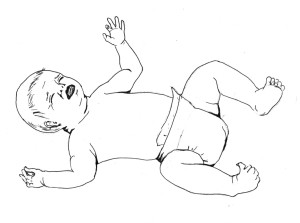Moro Reflex
- Change in head position
- Loud noise
- Sudden change of light in visual field
- Pain, temperature change, rough handling by caretaker
Response to Triggers
- Sharp inhalation
- Movement of the arms upward, away from body, hands open, then return of arms across the body, clasping hands
- Stress response: release of stress hormones (adrenaline and cortisol), increase in blood pressure, heart rate and breathing rate
- Possible emotional outburst
- An involuntary response to a threat.
- The reflex is present at 9 – 12 weeks in utero, is present at birth, and is integrated at 2 – 4 months.
- A survival mechanism, it is the earliest form of the “flight or fight” response.
This reflex is elicited by sudden changes in position, by sudden noise or light. The child with a retained Moro is always “on alert” and in a heightened state of awareness, which stimulates the production of stress hormones, adrenaline and cortisol. He can:
- Isolate himself, be fearful, have issues with showing affection and with socializing.
or
- Will be easily excitable, aggressive and have difficulties reading body language.
Because adrenaline and cortisol are involved with immunity and allergies, the child with a retained Moro could always be sick, and have allergies and sensitivities to foods and food additives and possibly burn sugar more easily than typical children.
Symptoms of a Retained Moro Reflex
-
Problems with Vestibular System
-
Motion Sickness
-
Poor coordination
-
Poor balance
-
Heightened awareness, in a “fight or flight” state
-
Tense muscle tone
-
Exaggerated startle reaction
-
Anxiety
-
Either excessive withdrawal from others or excessive aggression toward others
-
Timid
-
Dislike of changes or surprises
-
Poor learning skills
-
Low self-esteem
-
Emotional instability and sensitivity
-
Hyperactivity
-
Mood swings
-
Problems with vision
-
Eye movement and visual perception problems
-
Difficulty ignoring irrelevant material in the visual field
-
Difficulty with black print on white background
-
Light sensitivity
-
Tires easily under fluorescent lights
-
Hypersensitivity to auditory or visual stimuli
-
Poor auditory discrimination, difficulty ignoring background noise
-
Excessive release of stress hormones
-
Weak adrenals leading to allergies, frequent infections and low energy
-
Conditions related to low immunity, asthma, eczema, frequent ear, nose and throat infections
-
Adverse drug reactions
-
Biochemical and nutritional imbalances



